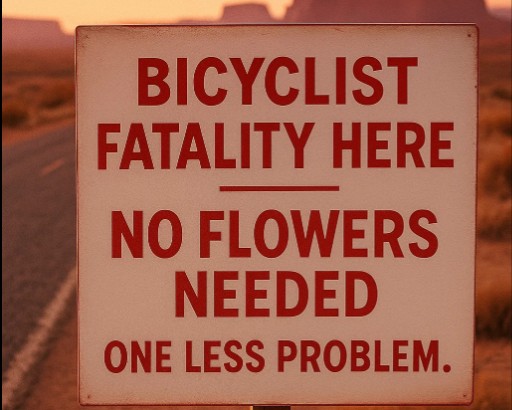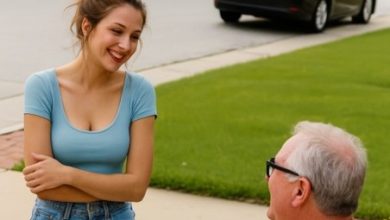They Posted a Sign Cheering My Son’s Fatal Crash at the Very Spot

The sign was nothing fancy—just spray paint on a sheet of plywood nailed to a fence next to Miller’s Curve, the spot where my son lost his life. The words punched me in the gut:
“ANOTHER BIKER DIES HERE — GOOD RIDDANCE! ONE LESS MENACE.”
I have ridden this road for forty-two years. I know every dip, bump, and tight turn. Yet when I saw those hateful letters, I suddenly forgot how to breathe.
My son Tommy was no menace. He was twenty-six, an EMT who spent weekends teaching motorcycle safety to new riders. He died because water gathers on that curve after every heavy rain, and the county never fixed the drain. Three weeks earlier, he hit that hidden puddle in the dark, slid out, and never woke up.
I pulled my bike onto the gravel shoulder. My hands—sixty-eight years old and usually steady—shook so hard I could hardly pull off my helmet. Rage like I had never felt washed over me. I called my lawyer. Then I sent a group text to every rider in my contact list. Whoever thought it was funny to mock my son’s death was about to learn why you never insult the dead, especially when the dead saved lives for a living.
The Gathering
A cold wind blew across the fields as I swung off my Harley. Dew sparkled on the plywood, proof the paint had dried overnight. Somebody picked the quiet hours to plant their cruelty right where Tommy’s blood mixed with rainwater.
I snapped pictures from every angle, my phone trembling. Over four decades of riding, I witnessed plenty of bias against bikers—being called thugs, turned away from diners, pulled over for nothing but wearing leather. But cheering a young man’s death? That was poison on a new level.
My name is Jake Morrison. I have buried brothers from crashes and cancer, but burying your own child cracks something inside you that never mends. Tommy followed every rule: always rode with full gear, reflective vest, bright headlamp. That wet curve ignored his skills.
The drainage there was installed in the 1970s. It clogs, water pools, and drivers hit a patch as slick as ice. We riders complained; Tommy even handed a binder of accident reports to the county commissioner. “Next year’s budget,” they told him. Next year was too late.
Now a stranger wanted to dance on his grave.
The rumble of engines broke my dark thoughts. First came Big Mike’s Road Glide, then Sarah’s Triumph, then a chain of bikes—sport, cruiser, dual-sport—forming a line down the road. Word travels at the speed of loyalty in the biker world. In less than an hour, nearly fifty motorcycles filled the roadside.
Big Mike, a plumber with hands like shovels, shook his head at the sign. “This is sick, Jake. Pure sick.”
Sarah, Tommy’s co-worker at the ambulance squad, filmed the plywood on her phone. “Keep evidence,” she told us. “This is harassment, maybe even a hate crime.”
When Father Patrick rolled up on his big burgundy Road King, I knew the story had reached far beyond our circle. The priest had blessed bikes at our memorial rides for fifteen years, but I had never seen fire in his eyes like that morning.
“It’s desecration,” he said, Irish lilt heavy with anger. “Your son sat with the dying and gave them peace. Whoever wrote this spit on sacred ground.” He placed a gentle hand on my shoulder. “Whatever you need, Jake—say the word.”
I wanted my boy back. I wanted the county to fix that drain yesterday. I wanted the author of those words to feel our agony. But mostly, I wanted the public to know the truth.
The Story Spreads
By midday, a news van parked near the curve. The young reporter looked uneasy among leather and denim, yet she stepped up with her microphone.
“Mr. Morrison, can you explain why people are gathering?”
I pointed to the curve. “Three weeks ago my son died here. Not because he was reckless, but because that drain is faulty. He served this county as an EMT. Now someone celebrates his death with a hateful sign.”
She asked what I’d say to the person who posted it. I stared into the camera.
“I’d ask them to tell the little girl Tommy pulled from a burning minivan why he ‘deserved’ to die. I’d ask them to tell the elderly man he revived in a grocery aisle why ‘one less menace’ is cause for joy.”
Right then a sheriff’s cruiser arrived. Deputy Williams walked over, hat in hand. We knew each other from small-town life.
“Jake, I’m under orders,” he said softly. “Your crowd could cause a traffic hazard. Folks are calling.”
Sarah crossed her arms. “This curve is the hazard, Deputy. We’re standing on public ground, mourning our friend.”
Williams sighed. “I don’t want to arrest anyone. Maybe we can all calm down?”
Before I could answer, a sharp voice chimed in. A woman in a gray suit slipped through the crowd.
“Amanda Chen, ACLU,” she said, flashing a business card. “I ride a Honda Shadow. These citizens are exercising their First Amendment rights. Dispersion without cause is unconstitutional.”
Williams retreated to his cruiser to radio his boss.
Meanwhile, the gathering turned into a community meeting. More people arrived: nurses from Tommy’s hospital, families he had helped at crash scenes, even strangers who read about him online. Dr. Martinez, still in scrubs, described how Tommy’s quick thinking saved countless patients.
One mother spoke through tears about her newborn son. “Tommy kept my baby breathing during the ambulance ride,” she said. “He wasn’t a menace. He was our miracle.”
Flowers, candles, and hand-written notes soon covered the fence. The hateful plywood looked smaller by the minute.
The Owner Steps In
A pickup truck pulled onto the grass. Out climbed Howard Brennan, owner of the land beside the curve. Pressed khakis, stern face. He marched toward the sign.
“This is my property,” he announced. “I can post what I please.”
So the culprit had shown himself.
“You painted those words?” I asked, voice calm but cold.
“Yep. I’m tired of you bikers roaring past my home, waking us up. Maybe that death will slow the rest of you down.”
“My son wasn’t speeding,” I replied. “He was going the limit. The flooded road took him.”
“Excuses. Two wheels, high risk. Play silly games, win silly prizes.”
I felt the crowd tighten behind me. But violence wouldn’t honor Tommy. I took a breath.
“Did you know his name was Tommy? That he was engaged to a kindergarten teacher? That he rescued puppies on weekends?”
Brennan folded his arms. “Irrelevant. Riders bring danger.”
A small hand tugged Brennan’s sleeve. An older woman stepped forward, tears shining.
“Mr. Brennan,” she said, voice trembling, “three years ago your grandson crashed his dirt bike on Route 47. Do you recall the EMT who kept him alive? That was Tommy Morrison. Look at his picture—same eyes your grandson kept thanking in recovery.”
Brennan’s jaw sagged. He glanced at the memorial, then at his sign. He whispered, “I didn’t know.”
Father Patrick spoke gently. “You didn’t want to know. You saw leather and chrome and assumed the worst.” He pointed to the flooding. “The danger isn’t the riders. It’s the road.”
Brennan’s face flushed crimson. He yanked his sign out of the ground, snapped it over his knee, and let the pieces fall.
“I’m sorry,” he said, voice cracked. “I was angry and ignorant.”
I swallowed hard. “Help us fix the curve,” I said. “Join our petition.”
He nodded, tears forming. “Yes. I… I will.”
Action, Not Anger
Photos of Brennan breaking his own hateful sign went viral overnight. Donations poured into the Tommy Morrison Safety Fund. Pressure mounted on the county board. Under threat of lawsuits and bad press, officials finally approved emergency funds to repair Miller’s Curve.
Brennan surprised everyone by speaking at the next county meeting. “I blamed riders for noise,” he admitted. “But noise saved my grandson’s life when an EMT on a bike reached him first. Fix the road. Honor that EMT.”
Repairs started within weeks. Engineers installed new drains, repaved the turn, and added reflective signs. The day the job finished, hundreds of riders met at the curve. We held silence for lives lost, then rolled through the turn—safe, no standing water, no hateful words.
Brennan stood beside a new plaque he funded himself:
“In memory of TOMMY MORRISON, EMT and Rider.
This curve made safe by those he inspired.”
A Changed Heart
Twelve months later, at our annual memorial ride, a small Honda Rebel pulled up. Brennan removed his helmet, hair wild, eyes bright.
“I took lessons,” he said shyly. “Had to know why you love it.”
On the ride, he navigated the now-safe curve. At the next stop he grinned. “It’s freedom,” he said. “Not recklessness. I was wrong.”
I smiled, picturing Tommy handing Brennan a beginners-course certificate from the clouds.
What Remains
I still miss my son every sunrise. But his true memorial isn’t the plaque—it’s a safer road and a community that learned not to judge leather and engines. Hate shrank; understanding grew.
Every time I ride through that curve, I hear Tommy’s voice teaching students: “Respect the road, respect each other, gear up, ride smart.” I whisper back, “Got it, kid.”
And I picture him somewhere above, knees bent, leaning into a perfect turn on roads that never flood—making sure every new arrival rides home safe.



